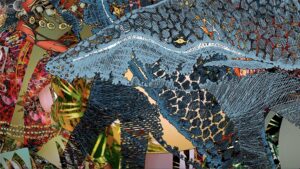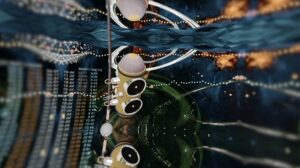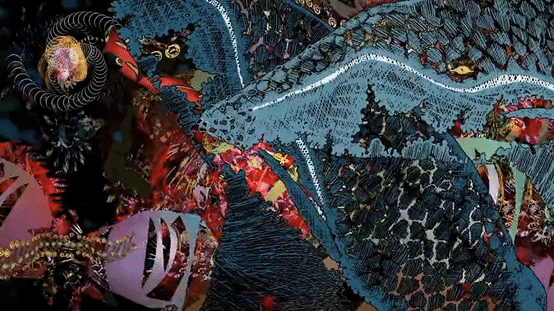Forty years ago, artist Karen LaFleur realized that she could make designs using a dot matrix printer. She painstakingly typed alternating Xs, Os, symbols, and blank spaces on her computer keyboard, then printed out the results to create images instead of drawing them by hand.

By the late 1990s, laser printers and software advances allowed her to add color and depth to her digital art. “And then, all bets were off,” she says. “I just loved working with machines because you got to be master of the universe with what you were creating.”
LaFleur, who lives in Yarmouth Port, has been making digital art ever since. But only recently has she found a community with which to collaborate and share her knowledge — an online “techspressionist” group, founded in 2020 by artists Colin Goldberg, Oz Van Rosen, and Steve Miller. Their website defines techspressionism as “an artistic approach in which technology is utilized as a means to express emotional experience.”

The term recently emerged worldwide, LaFleur says, out of a need to better describe what these artists were making. “ ‘Digital’ wasn’t doing it for us,” she says, “because digital is also special effects in Hollywood or video games. That’s all wonderful, but it’s not what we do.” The group now has 400-plus members from nearly 50 countries. They stay connected through virtual salons and panels, public online exhibits, and social media.

It was among the techspressionists that LaFleur — the only Cape Cod member and one of just two in Massachusetts — virtually met Renata Janiszewska, who, living in the 800-resident lakeside Ontario village of Lion’s Head, had also felt lonely as she’d made digital art.
Janiszewska had previously worked with paper, canvas, printmaking, and sculpture. Her art-making changed after she discovered the iPod Touch in 2010. It was small enough to hold in her palm and draw with her thumb on the screen.

Next, she got an iPad, which allowed her to turn her drawings into elaborate, colorful paintings. She began by using her finger to draw directly on it. Then she started using a stylus and software to create custom brushes and colors. She held her first iPad show in 2011: five images were displayed on 8-by-4-inch screens and other printed images were collected in a catalogue.
The seemingly limitless possibilities, especially with colors, were what drew her in. “Color is about emotion,” Janiszewska says, “and the fact that I can mix any color I wish on my software programs is invaluable for my personal expression.”

LaFleur and Janiszewska have combined forces for the exhibition “Mariniana: The Interrupted Wave,” which is on view through Feb. 9 at the Cape Cod Museum of Art in Dennis. The exhibition, shown in the D’Alessandro Auditorium, is presented as a 25-minute video loop of moving images. It can be watched in its entirety or in pieces, like paintings in a gallery.
“Mariniana” is only the techspressionist group’s second show in a museum, following a late summer exhibition in Brooklyn. And it’s CCMOA’s first — created specifically at the museum’s request with an ocean theme. For “Mariniana,” LaFleur chose to focus on ocean science, and Janiszewska chose myth.

For her moving-image work, LaFleur creates finely detailed pencil drawings on layers of vellum paper, scans them as files on her computer, then digitally paints and animates her work. She divided her section of the “Mariniana” video into three pieces: Aqua Columna, Aqua Turbulentum, and Aqua Planeta, each featuring swirling water and rotating feathery shapes in collages of pinks, purples, blues, and golds.

Janiszewska paints directly onto a digital canvas. Her myth-inspired section of “Mariniana” is also a trilogy, focusing on Inuit tales of Sedna, stories of mermaids, and Greek and Roman myths about sirens. Her female subjects have smooth skin and long locks that wave in the underwater currents. Colors blend as images morph around the pink-cheeked figures, fracturing into small shapes that divide, meet, then flow apart.

Both artists’ pieces are accompanied by ethereal soundtracks. Janiszewska wrote, recorded, and produced her own music, and LaFleur collaborated with composer Nancy Tucker, an old friend.
The two artists, who have not yet met in person, presented a virtual techspressionist salon on “Mariniana” on Dec. 5 and will answer questions at the Dec. 12 reception with Janiszewska joining on Zoom. They feel encouraged by the growing worldwide embrace of techspressionist work among newly connected artists, particularly younger ones, and museums such as CCMOA.
“This community is my tribe, and I’ve never had that as an artist before,” says Janiszewska. “It’s life-changing.” While curating the group’s social media, she’s noted reactions from artists as far away as Russia, India, Turkey, and Brazil. “They feel like ‘Somebody cares about this, somebody is interested in my work.’ ”
While techspressionist art has been widely available virtually, the two artists say, “on-land” options have recently spread to airports, office buildings, and other commercial spaces. In more traditional settings, Janiszewska says, the Whitney Museum of American Art in New York City has had a curator mounting digital art shows since 2000. LaFleur says she’s found many museums and art centers eager to make the leap — including showing “Mariniana” beyond Cape Cod.
“To excite the next generation and be an organization for all the arts, we need to have digital arts and media,” says CCMOA director of art Benton Jones on a day when Monomoy High School students on a field trip fill the D’Alessandro Auditorium seats. “Younger generations might not see themselves behind a canvas with a paintbrush, but they could see themselves using tools like their phone, iPad, or laptop to express themselves.”
Technicalities
The event: ‘Mariniana: The Interrupted Wave,’ an exhibition
The time: Through Feb. 9; artist reception Thursday, Dec. 12, 3 to 5 p.m.
The place: Cape Cod Museum of Art, 60 Hope Ln., Dennis
The cost: Reception is free; admission to museum, $10 for adults, $8 for seniors, $7 for students



